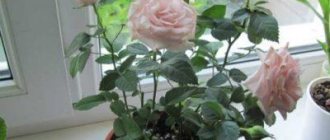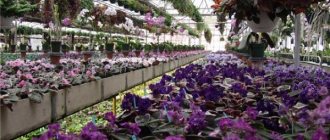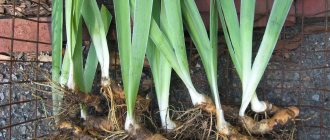Hello, friends! Have you got an indoor rose or are you just dreaming of one, but are you afraid to buy it because you don’t know what to do with the flower next? After all, you have heard that these capricious plants do not live long at home and quickly die even with what the owner seems to be good care for. Why is this happening?
The thing is that producers are not interested in the long life of the rose bush. It is important for them to sell as many specimens as possible, so when growing they use various stimulants for rapid growth and flowering, which shorten the life of our favorite flowers.
But is everything really that bad and the plant will definitely die? No, of course, he can be saved. If you agree to pay special attention to the queen of flowers, then you can “reprogram” her for a long life in your home, and then plant her in the garden or grow her on the balcony.
But let's start from the very beginning: let's go to the store and choose a worthy copy, and then we'll figure out what to do next with the capricious newcomer.
Description and features
Types of dwarf crops
Bengal
This species was brought to Europe from Bengal, which is why it got its name. The Bengal rose bush grows 40-50cm in height. The leaves are pointed, dark green. The shape of the flowers is slightly flattened, and their color can be red, white or pink.
Teahouse
Tea rose was brought from China. Its aroma is reminiscent of tea, which is why it got its name. There is another version - its blossoming flowers resemble the shape of a Chinese tea bowl. The bush of this rose grows 50cm. The leaves are dark green. have an oval shape. The flowers are double, large, and their colors can be very different.
This species has a long flowering period. This is the only type of rose from which tea can be made.
Mix
The bush of this interesting type of dwarf roses looks like a ready-made bouquet. They are not classified into varieties for sale, which is why they are called that. It comes in miniature (up to 30cm) and patio (up to 50cm). She comes in a variety of colors. Flowers are medium sized, flattened.
You can learn more about the varieties of the lovely mixed rose and the features of its cultivation here.
Polyanthus
It is also called multi-flowered. It can reach a height of up to 50 cm. The flowers are small, double or semi-double, and have no scent. The flowers are collected in inflorescences and are distinguished by a variety of color shades.
Botanical description
Belongs to the Rosaceae family. Most often, dwarf roses are evergreen multi-stemmed shrubs, the height of which varies from 10 to 50 cm. The leaves are alternate, compound, with stipules, each of which contains 5-13 oval or round leaflets. The surface of the leaves can be shiny or matte, their color is usually dark green.
The stems of most types of dwarf roses are covered with thorns. The diameter of flowers can be from 1 to 5 cm. Flowers can be single, double or semi-double. Their shape can be spherical, flat, goblet or cupped. The shape of the petals can also be different: they can be bent, flat or wavy. Dwarf roses can be of all colors and shades, there are not only blue ones.
Peculiarities
The main feature of miniature roses is their small size. Another feature is that this species is suitable for growing both indoors and outdoors. The size of mini roses makes it convenient to grow them at home, and due to their frost resistance, they are also suitable for open ground.
Another distinctive feature of these roses is that they make excellent decorations for borders, verandas and attics, again due to their small size.
Pros and cons of growing miniature species in pots at home
The benefits of growing miniature roses at home include:
- decorativeness;
- long flowering period;
- variety of colors and shades;
- resistance to diseases and pests.
The disadvantages of growing mini roses at home include:
- dwarf roses are more whimsical than ordinary ones;
- small sizes (not everyone likes this).
Origin story
The history of the origin of dwarf roses is not entirely clear. You can find several versions of the origin of the species in different sources: some of them say that the flower’s homeland is Europe, others believe that it was brought from Southeast Asia. But according to the classical version, it is believed that the miniature rose was brought from China.
How to choose an indoor rose in a store
When choosing a flower, follow a few simple rules so that the purchase does not upset you in the very first days of life at home. These tips will be especially useful for inexperienced gardeners, for whom caring for a sick or weakened plant will be difficult, so you need to immediately choose a healthy and strong specimen.
First of all, pay attention to the stems: they should be strong, with intact bark. The foliage should also be healthy: dense, shiny, without black or red spots. But most often this is true, since manufacturers monitor their products.
There are different things about the presence of flowers. If a plant has a lot of buds, this is good; it has not yet devoted all its energy to flowering. If the flowers are already fading, but the leaves are strong and healthy, then that’s also normal. This means that life in a dark store did not take all the strength, and this is a hardy specimen.
But, of course, we want to choose and buy a miniature rose in full bloom. And we buy if there is such a desire. We choose the pot that we really like. It should be borne in mind that when growing miniatures outdoors, the flowers may slightly change color. For example, the flowers of my yellow-flowered bush became almost orange, and the flowers of my red-flowered bush became dark burgundy.
If you buy a plant in winter, then you need to pack it well so that it does not freeze during the journey.
Sometimes in the store you can see very small plants, but with a huge flower. You must understand that the bush will not remain like this. Most likely, this is a miniature Cordana, and it will grow up to 25-30 cm. And if this species belongs to patio roses, then up to 50 cm. Unfortunately, the variety is very rarely indicated on pots, and when buying, we often play the lottery .
Content requirements
Place
When growing a mini-rose, you must provide it with good air exchange, so the best place for its location would be a balcony. You can put a pot of roses on the windowsill, but you will need to open the window often. In summer you can take the flower with you to the dacha.
Temperature
During flowering, which occurs in the summer, the plant needs fresh air, so try to place the flower on a balcony or loggia whenever possible.
Remember that roses do not like extreme heat, so try not to let the soil overheat. Choose light-colored pots, and in the hot season, wrap the flower container with reflective material.
Room temperature will be ideal for potted roses. Cold air is also harmful to it, so make sure that on cold days there is no blowing from the windows, and if you use a fan or air conditioner, place it away from the plant.
Humidity
During the development and flowering of a rose, it is necessary to spray it. You can give her a warm shower once a week.
In any case, you cannot ignore moisture, as this can lead to drying out of the leaves or, even worse, the appearance of pests (more on them below).
Lighting
The dwarf rose is a light-loving plant, therefore, it needs good lighting. But the scorching summer sun can damage the flower, so try to protect it from direct sunlight, especially at midday. In the morning and evening hours, the sun is not dangerous for the rose.
Main conclusions
From this note you learned that indoor roses require careful care throughout the season. She needs a sunny place, a lot of fresh air, fertilizing, treatment for spider mites, high humidity in winter and cold wintering.
If you can provide the beauty with these conditions, she will delight you with flowering until autumn. If you do not have such conditions, I advise you to plant the plant in a large pot and grow it in the country, and then dig up a rose bush and leave it there for the winter.
This is better than tormenting him in a hot room with the central heating on. That's all I have for today. Natalya was with you. Have you ever been given a miniature in a pot? How did it end? Share in the comments!
Growing and proper care of flowers in pots
Landing
Landing is carried out according to the following rules:
- Prepare a container.
- If the container has already been used, clean it with a brush, do not use detergents.
- You need to make good drainage. For this you can use expanded clay: if there is a hole in the pot, the layer of expanded clay should not be more than 1 cm, but if there are no holes, then at least 3 cm.
- The soil needs to be nutritious and breathable. You can buy soil in the store or prepare it yourself by mixing turf, humus and sand in a ratio of 4:4:1.
Watering
In summer, the rose needs abundant and regular watering. Do not allow the soil to dry out. But if the summer is cold, then do not overwater the plant; for it, an excess of moisture is worse than a lack of it. After flowering has finished, watering should be stopped. During the wintering period, you need to water the dwarf rose, but very rarely, 1-2 times per period is enough.
Watering is resumed with the appearance of buds on the flower and increases as it grows and new leaves appear.
Water for irrigation should be warm, not lower than room temperature.
Top dressing
It is necessary to fertilize a rose only during the period of bud setting and flowering. Once every 10 days, feed your flower with a special fertilizer for flowering plants. By the end of flowering (beginning of autumn), fertilizing should be stopped.
Trimming
Pruning should be done after the plant has finished flowering, but spring pruning can also be done. Leave 4-5 buds on each branch and remove the rest (except leaves). Pruning the plant is the key to abundant flowering; it must be done.
Transfer
Potted roses do not like replanting, so it is carried out only if the pot is small.
The transplant is carried out as follows:
- We choose a larger container, clean and rinse it.
- The plant has very delicate roots that are very easy to damage, so it is better to soak the flower pot for half an hour. This way the earthen lump will be better separated from the pot.
- We transfer the earthen lump into a new container, sprinkle it with earth and compact it well around the plant.
It is not recommended to water the rose after transplantation. Place it in a dark place for a week, then put it back in a lighted place.
Prevention from pests and diseases
In order to prevent a flower from becoming infected, you need to:
- Make sure that the soil does not become waterlogged.
- Maintain sufficient air humidity.
- Protect the plant from drafts.
- Keep the flower away from direct sunlight.
Also, after purchasing a plant, you can treat the rose with Fitoverm, which will provide protection against pests.
Propagation of indoor crops
Dwarf roses are propagated by cuttings. They do this as follows:
- Using a knife, which must be treated with a solution of potassium permanganate, cut a stalk 10 cm long.
- The cut should be made directly under the bud, preferably oblique.
- Make the upper cut 5mm above the kidney.
- Remove leaves from the bottom of the cutting.
- Place the cuttings in water for 10 hours.
- Plant the cuttings in the prepared mixture of sand and peat.
- Heavy watering is not necessary, otherwise the cuttings may rot.
- Ensure a stable temperature of at least 18 degrees and protect cuttings from exposure to direct sunlight.
Reproduction of dwarf rose
Regular indoor roses are propagated by cuttings.
This is the propagation of plants using annual green shoots that produce buds. The method is considered the most popular and simple. In order for roots to form in water, propagation is best done during the growth period - in spring or summer. At this time, dwarf roses bloom profusely in pots that are placed on the sunny side.
It is best to take a shoot with a bud, but you can also use a faded branch. From below, a shoot no more than 15 cm long is cut at an angle, from above - straight. In this case, the cutting must have at least two buds, which will subsequently sprout.
The temperature of the water for the cutting should be room temperature, and the liquid must be boiled.
It is advisable that the container for germination be made of dark glass or material, and the container itself should be placed on a windowsill or any other place with plenty of light.
After the roots appear, the cuttings must be transplanted into a small container with soil. Caring for such a home dwarf rose is no different from caring for a regular one. After the first bud appears, the flower can be transplanted into a larger pot.
Diseases and pests
Home roses can be affected by diseases and pests such as:
- Chlorosis. The appearance of this scourge can be recognized by yellowed leaves. Iron chelate effectively combats chlorosis.
- Powdery mildew. Its appearance is indicated by white spots on the leaves and stems of the plant. Fungicides are used for treatment.
- Spider mite. This pest leaves a thin web between the leaves. To combat it, the drugs Fitoverm and Apollo are used.
- Thrips and aphids. Deformation of the leaves and flowers indicates that the plant is infected by these pests. For treatment, insecticides for indoor plants are used.
What kind of roses do we buy?
J. Tadeusz: “Most often, various varieties of miniature roses are sold as potted roses. These are Cordan roses, which are characterized by compact bushes and small flowers. Similar to them are Turbo roses, but with larger flowers, and Patio roses. Patio roses are a group of garden roses that are also successfully grown in the garden. They are characterized by larger bushes and the flower itself than miniature roses.”
Potted roses purchased at a flower shop have the property of continuous flowering from May to October and a compact shape, up to 15-25 cm in height. The size of their flowers does not exceed 1.5-2 cm in diameter, they have a variety of colors, doubleness and fullness of the bud, and often the aroma.
The age of such plants is only 2-3.5 months from rooting. As a rule, they are sold planted 4 pieces in ten-centimeter pots or 3 pieces in six-centimeter pots. They haven’t really gotten stronger yet, but there’s such stress here – changing from the comfortable conditions of professional greenhouses to the far from ideal conditions of our apartments.
Miniature rosesRosa CordanaRosa Patio
J. Tadeusz: “Before you buy, inspect the bush carefully; how long it will live with you largely depends on its condition. Only very experienced gardeners can pull out a completely weakened plant. First of all, inspect the shoots and leaves. The shoots should not have black spots; this may indicate the presence of a fungal disease. The leaves should be green, dense and shiny in appearance and adhere well to the shoots. A white coating on the leaves indicates powdery mildew, while brown or black spots indicate fungal spots on the rose. Yellow color and falling leaves mean that the plant is depleted or has been overwatered. Be sure to check for pests. Indoor roses can be affected by scale insects, mealybugs and the scourge of indoor roses - spider mites.”
Errors, consequences and their correction
Problems when growing mini roses at home can also arise due to improper care. What problems could these be?
- The plant does not develop or grow. The cause may be poor nutrition. To eliminate the problem, you need to regularly feed the flower.
- Leaves are falling. The reason is increased soil acidity. The problem can be solved by liming the soil.
- The leaves turn yellow and wither. Have you noticed this problem in your plant? This means he doesn't have enough light! Choose a well-lit area, and use additional lighting in the form of lamps in winter.
- The rose doesn't bloom. The fact is that you haven’t replanted your rose for a long time! Although she doesn't like it, this procedure needs to be done every 2 years.
A rose bush can be a wonderful decoration not only in the garden, but also in the house. On our website you will find articles about such types of indoor roses as Cordana and learn how to grow a bush rose in a pot.
A miniature rose is a great option for decorating your home. The variety of colors and types allows you to make a choice among its many varieties. Of course, it is quite difficult to care for it, but the result of your labors will not be long in coming - your flower will delight you with its flowering for a long time.
What you need to know when planting a miniature rose outside
I didn’t keep my miniatures, which I bought out of pity in poor condition in early spring at the Magnit store, at home, because for me fighting ticks all summer is not a pleasure. I don’t like working in an apartment with chemicals, so as soon as it got warmer, I planted them several at a time in large pots (5-10 l) and sent them to the dacha.
True, it should be noted that I did not plant it immediately in such large containers, but with transfer from smaller 2-3 liter pots. In large containers outside they bloomed beautifully until autumn. I fertilized as usual, in minimal doses with each watering.
At the end of October, I pulled the bushes out of the pots and buried them in the garden, and covered them with earth on top. They overwintered well, and in the spring they moved back into the same pots. I replaced the substrate with a fresh one, since the old one was already depleted.
It seems to me that there is no point in keeping small rose bushes in the ground, because beautiful flowerpots emphasize their beauty and grace, and in a flowerbed they would get lost among their larger neighbors.
If you decide to keep your miniatures outside, be prepared for constant treatments for black spot. My Cordana roses turned out to be not very resistant to this disease. Spraying should begin at the beginning of the season, when there are no signs of the disease, which is expressed in the appearance of black spots on the foliage and its falling off.
Copper-containing preparations such as “HOMA”, Bordeaux mixture or others that are available for sale in your stores are suitable for treatment against spotting.
If you want to plant a miniature in the ground, be prepared for the fact that by the end of the season it may not turn out to be a miniature at all, but will grow into a hefty bush. I saw such a specimen in my friend’s flowerbed. It was a beautiful variety, but very large, and far from indoors.
As I already mentioned, the manufacturer rarely writes on the label what kind of variety is offered for sale. As a result, we buy a “pig in a poke”: it could be a low Cordana; and a rose from the patio group, which grows up to 50-60 cm; and ordinary floribunda or even hybrid tea, treated with retardants to inhibit growth.
What care is required after purchase
Before you buy a rose, you need to carefully examine it in the store. The leaves should be smooth, shiny, and not wilted. They should not have dark spots or yellowed areas. You need to start caring for the flower immediately after purchasing it in the store. The first 2-3 weeks are especially important. The rose is very sensitive to changes in location, so it can shed all its leaves and buds. But with proper care, new flowers may appear within a month.
Adaptation period
When you bring a rose home, you need to wash it well under a warm shower. Treat with a fungicide to prevent pests. The plant for sale is kept in a peat substrate and stimulants are added so that it does not lose its attractiveness. But such a substrate is not suitable for growing at home. The rose needs to be transplanted into a container with suitable soil in a new pot. But this can be done when it adapts to a new place - 10-12 days after purchase.
The best method of replanting a flower is transshipment. This way the roots are kept as intact as possible. Pour a 2 cm layer of drainage into a new pot, then add a layer of prepared soil for roses. The earthen ball with the plant should be completely immersed in the new container. Fill all the voids with soil and water the rose. Treat with a growth stimulator according to the instructions (for example, Epin). Then no fertilizers can be applied for 2 weeks. Trim all flowers and buds. While the rose takes root, some of its foliage may fall off. There is no need to be afraid of this. New shoots will appear soon.
Step-by-step instructions: how to propagate a flower at home?
Indoor roses can be propagated in several ways.
By cuttings
Cuttings are not only a propagation method, but also an excellent way to rejuvenate an adult plant. The process itself is very simple and does not require much effort or special knowledge.
The cuttings should have buds, since it is the buds that will nourish the plant before planting and help the roots grow faster. It is necessary to cut off the apical cuttings that do not have buds. The stems must be mature.
Important! Before propagation, cuttings must be watered abundantly. The container with cuttings must be covered with a bag
Be sure to put it in a bright place.
You can root cuttings in jars of water, in soil, or even in potato tubers. If you are planning to root roses in water, you must:
- Cut branches up to 12 cm long from the mother flower at an oblique angle.
- Clear them of leaves.
- Place in a container with water.
- It is necessary to periodically ventilate and moisten the soil.
- After rooting, the plant must be planted in separate pots one at a time; in extreme cases, 2-3 can be planted.
- It is necessary to pinch the tops to increase branching.
Below is a visual video about the propagation of roses by cuttings:
We talked about the stages of cutting roses in the fall at home and caring for the plant immediately after the procedure here.
Dividing the bush
Shrub roses are mainly propagated by dividing the bush.
Before propagation, the rose bush must be trimmed as short as possible so that the branches do not take away moisture and nutrients.
Attention! It is advisable to divide not the grafted bush, but the one that was originally rooted into the ground. Such bushes grow quite widely, and for propagation you only need to dig up a small part of the root system and cut it off with pruning shears. If propagation of a rose by dividing a bush is carried out in early spring, then it is necessary to carry out the procedure until buds appear on it
If a rose is propagated by dividing a bush in early spring, then it is necessary to carry out the procedure until buds appear on it.
There is nothing complicated in dividing a bush, for this:
- Dig up a bush and cut off its branches.
- Separate the roots from the main plant and plant the plots so that the roots are completely underground.
- Water the planting site and cover it with soil.
By layering
This propagation method does not give one hundred percent success in growing a flowering plant. Therefore, this method is resorted to if roses take root poorly or do not take root at all. These varieties of roses include climbing and ground cover roses.
The ideal time for planting is spring.
For propagation by layering you need:
- Choose strong annual shoots (lashes).
- Place the lashes in pre-prepared grooves with fertilizer. The grooves should be dug next to the mother bush. This is a prerequisite for creating intensive nutrition of the plant with useful substances and rapid rooting.
- One of the layers should be pinned to the soil, and the others should be laid out on the surface of the soil.
- Cover the cuttings with soil and water generously.
If everything is done correctly, then in the fall the cuttings should be dug up, separated from the mother bush, and transplanted to another place. In winter, layering should be covered so that the plant grows stronger and develops well.
Seeds
Seeds for propagation should be taken from unripe fruits, this will increase their germination. The seed capsule is cut in half, the seeds are removed from it and washed in a solution of hydrogen peroxide. Seeds are placed in a prepared cotton pad for stratification in the refrigerator. After a couple of months, the seeds will begin to germinate, the sprouts are transplanted into separate pots.
The time for planting seeds depends on climatic conditions.
Read about how to plant rose seeds at home and root seedlings in open ground here, and this material tells how roses are obtained from seeds from China and how to grow them at home.
What to do
Foliage
Light mode. If a flower has been moved from a dark place to a lighter one, it will become stressed. It is necessary to gradually accustom the rose to the sun's rays. If, on the contrary, additional lighting will be required at first. Review of the watering regime. Watering is done as needed; the soil should not be allowed to dry out completely. When water stagnates, root rot forms. To save the plant, it is pulled out of the pot and the root system is carefully washed. Rotten and dry roots are cut off. The cutting areas are treated with Kornevin. It is worth paying attention to the fertilizing performed. An excess of nitrogen and phosphorus fertilizers in the soil is harmful. Experienced flower growers know that nitrogen can cause a burn that causes foliage to fall off. Periodically, indoor roses are inspected for various diseases and pests. Dangerous diseases include chlorosis. A plant suffering from it loses all its leaves and shoots, and then dies completely.
Important! The only way to save the flower is to replant it in new soil and feed it with fertilizer containing iron. Dark spots and cobwebs are a clear sign of a tick
It affects the leaf blade. It is recommended to treat the affected areas with a soap solution. If this procedure does not help, use chemicals:
Most often, buds fall off for the same reasons as leaves. You should follow all the above instructions to avoid trouble. Formed weak buds indicate that the pot is small in volume. The capacity changes as the flower and its root system grow. The main reason for the shedding of buds is tight containers.
Roses often lose their buds. This may be due to the following reasons:
- Draft. If cold air hits the plant while ventilating the room, this will cause the buds to fall off.
- Cold irrigation water. With the advent of an indoor flower, you should learn how to water a rose and how to care for it. If these rules are not followed, it will not only shed buds, but may also die. To prevent this from happening, the plant is watered with settled water at room temperature. Cold humidification should not be carried out.
- Incorrect transplant. The indoor rose is moved to another flowerpot during the period when there are no buds on it. If this is done at another time, then even if the roots are slightly damaged, it will shed them.
- Low humidity levels. In the presence of such an atmosphere, spraying is carried out. During the procedure, make sure that drops of water do not fall on the buds, otherwise they will fall off.
- Lack of nutrition. When the soil is depleted, the buds wither. To prevent this from happening, the plant is watered with phosphorus-potassium complex fertilizers. Failure to comply with the dosage also leads to the buds falling off.
- Lack of light. When there is a lack of light, the rose's photosynthesis slows down, which leads to the flowers falling off.
- Pests.
To save the plant, it is necessary to reconsider the conditions of its maintenance and care. You should start by changing the light mode. If a rose has been moved from a dark room to a more open place, then due to stress it begins to shed its leaves. To avoid this, the rose is gradually accustomed to sunlight. If you plan to move the pot to a darker place, then additional lighting will be provided on it.
Be sure to look at the watering regime. It should be carried out as needed, but the soil should not be allowed to dry out completely. When water stagnates, the plant is affected by root rot. How to revive roses in a pot if their roots are damaged? To do this, the bushes are pulled out of the containers and the food system is washed. All dry, rotten roots are removed. The cut areas must be treated with Kornevin and sprinkled with activated carbon.
When fertilizing, you must carefully read the instructions. An excess of nitrogen and phosphorus fertilizers leads to burns and causes leaves to fall off.
There is a significant difference between outdoor and indoor roses, the basis of which is the influence of external factors affecting the growth and development of the plant.
Outdoor planting cannot be completely protected from temperature influences, wind and rain. The causes of drying out are the same, as is, in principle, the fight against them.
Watering and fertilizing mode
Roses should be watered at the root or in a tray only with warm water; cold water can cause them to hurt. It is better to alternate these two methods. In the summer, it is necessary to moisten the soil more often, but with the onset of autumn, the interval between waterings must be increased.
With the arrival of spring, or even better, from the second decade of February, the dwarf rose needs regular feeding with organic matter and complex preparations, but not more than 2 times a month. There is no need to apply fertilizer in autumn and winter.
Nuances for different times of the year
In the spring, the overwintered plant produces many young leaves and then buds. Roses love south or southeast windows. Plants are placed on window sills in February and fertilizing begins every two weeks.
It is important to maintain humidity conditions. In summer, they bloom best in the fresh air, for example, on an open balcony. It is necessary to ensure that the containers in which the plants are planted do not overheat in the sun
If you have a summer house, you can plant rose bushes in flower beds or place pots of flowers on an open veranda. The main thing is not to forget about timely watering, since in the open air the soil in pots dries quickly due to the wind.
In the fall, cut off excess branches and move the plants indoors. Roses need a period of rest during the cold season. It is not recommended to replant adult plants in the fall. It's better to do this in the spring. In winter, roses need rest. Sometimes they overwinter well on cool window sills, but it’s even better to move them to an insulated balcony, wrapping the pots with thermal insulating material.
Choosing the “right” rose: educational program on the variety series of indoor miniatures
There are several hundred varieties of miniflora varieties and this list is growing every year.
Many chic varieties of roses, including miniatures, were bred in the Danish nursery Poulsen Roser A/S. Here, in 1981, the first miniature “house” rose was created - the Teeny Weeny variety from the PARADE variety series. PARADE roses are compact, with thin leaves, but rather large flowers (5-8 cm in diameter), blooming profusely and often.
Indoor rose Cajsa from the PARADE series
The same breeder developed a series of miniature house roses PATIOHIT (Patio Hit) - with large colors and more powerful bushes than PARADE roses.
Rose Imola from the PATIOHIT series
A little later, the PARTY variety series was developed - a dwarf version of PARADE, the height of these plants upon delivery does not exceed 10-15 cm.
Miniature rose Breeze from the PARTY series
Another well-known nursery from Germany - W. Kordes` Sohne - brought to the markets a popular variety of indoor roses - KORDANA (Kordana). These are dense, clustered bushes with dark glossy foliage and multiple colors. There are roses KORDANACLASSIC with flowers with a diameter of 2-4 cm and KORDANA GRANDE with flower heads more than 4 cm in diameter. The Cordana rose in a pot is often sold in our flower shops; caring for it at home is the same as for other varieties of potted roses.
Rose Bonanza Kordana GrandeAmong collectors, roses from the breeding work of a Danish company, Roses Forever ApS, are also highly valued. Thanks to her, the world received such popular brands of miniature roses as ROSES FOREVER and INFINITY. In the ROSES FOREVER series there are varieties with very large flowers, for example, in ROSES FOREVERNEVADA and ROSES FOREVERMARINA, the diameter of the flower heads is 15 cm.
Mini rose Roses Forever, Moscow by Night
The INFINITY series varieties bloom flowers with a diameter of 7 cm (which is also quite a lot for potted roses!). This series is revered by many flower growers as a masterpiece of worldwide selection. The INFINITY bush is not tall, the stems are thick and juicy, large, dense flowers of a very beautiful configuration. Moreover, the lifespan of each flower is about 5 weeks, so you can admire the beauty of a flowering plant for quite a long time.
Mini rose Infinity, Princess of Infinity
Temperature and humidity
Potted roses require moderate temperatures in summer and cool temperatures in winter.
At home, such plants suffer more from overheating and drying out of the soil. Suitable maintenance temperature in summer is from 20 to 25 °C. But slight fluctuations will be useful. In winter, roses are moved to a cool place, where it should be 10-15 ° C. In the room where such plants are located, moist air is desirable. In a very dry environment, the bushes become infected with parasites, so spraying must be carried out regularly (every 2 days). If the potted rose is located in a cool room, then it does not need frequent spraying. And to remove dust from the leaves, you can take a short warm shower. By the way, on a sunny day it is better not to splash water on the flower itself, as this can cause damage to the buds and the development of fungal diseases.











